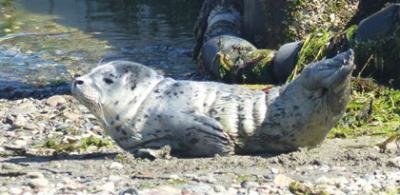
Seal Pup Primer

This morning, I watched a seal pup casually floating on her back, with hind flippers flexed, drifting gently in a Salish Sea current. A few gulls kept her company. On Vashon-Maury, we can expect to see Harbor seal pups – newborns and “weaners” --into early October. Chez VHP’s summer travel schedule interrupted our work as stranding responders and delayed dissemination of our annual Seal Pup 101 information.
Hauling out is normal pinniped behavior. Pinnipeds -- seals and sea lions -- do it everyday. They come ashore to rest, thermoregulate, mate, give birth, nurse young, and molt. In urban Puget Sound, pinnipeds use manmade structures and even large marine debris because many shorelines are unnaturally armored and highly developed.
Typically, seal pups on land are not abandoned or ill. Mother seals leave their pups alone, sometimes for many hours, while they forage offshore. Pups nap on beaches, rafts, boat ramps, stairs, and bulkheads. Inexperienced or first-time mothers are more likely to park their pups in less desirable, high-traffic areas, such as the boat ramp by La Playa Restaurant and busy beaches at Point Robinson, KVI, and Dilworth.
Newborn seals look appealing and helpless, but resist the impulse to touch or feed them. Do not move them, douse them with water, cover them with blankets, or stuff them in a backpack, car, bathtub, ad nauseum! Do not encourage baby seals to climb aboard kayaks, SUPs, or other watercraft. Ideally, maintain 100 yards distance from pups; respect their space and comply with wildlife laws.
Harassing marine mammals violates the Marine Mammal Protection Act (MMPA) -- federal law that protects seals. Harassment or disturbance occurs when people impede a marine mammal’s ability to hunt, feed, rest, breed, communicate, socialize, or care for young. Moreover, frightened seals can bite and transmit diseases to dogs and humans.
If people and dogs loiter around a seal pup, thereby preventing Mom from returning to nurse her baby, Mom might ditch the pup. Disrupting feeding and maternal bonding jeopardizes pup survival. Interfering with natural behavior by “rescuing” a seal pup who is not in trouble imperils the pup’s adaptability in the wild. Seal rehab centers have severely limited space, and pups released from rehab face an uncertain future. Studies show that they do not hunt as proficiently as wild-reared pups. People are poor substitutes for seal mothers.
Dear readers, we urge you to immediately report seal pups on beaches where crowd control is an issue. A simple phone call can save a baby seal’s life. We extend a shout-out to the Vashon Nature Center for referring calls to us from Islanders with concerns about seals.
Here is a link to NOAA’s “Sharing the Shore with Harbor Seal Pups” fact sheet -- http://www.nmfs.noaa.gov/pr/pdfs/health/northwest/sharetheshore_harborse...
Odin and I are the marine mammal stranding responders for Vashon-Maury, in collaboration with researchers from NMFS/NOAA, WDFW, and Cascadia Research. We strive to educate and maintain harmony between seals and humans. Help us to eliminate pup abandonment due to human interference and avoid unnecessary rehab placements for our baby seals.
Please support the work of the Vashon Hydrophone Project (VHP): REPORT LOCAL WHALE SIGHTINGS ASAP TO 206-463-9041, as well as seal pups and sick, injured, or dead marine mammals on Island beaches. We are still in seal pup season. Prompt reports to the VHP expedite vital data collection efforts and sustain an accurate record of whale sightings for Vashon-Maury initiated three decades ago by Mark Sears. Send photos to Orca Annie at Vashonorcas@aol.com
- Login to post comments
